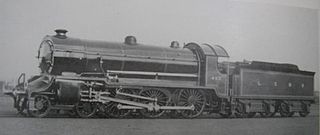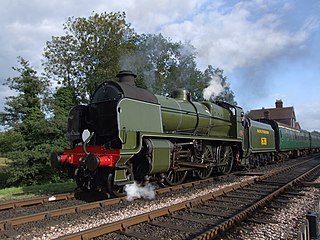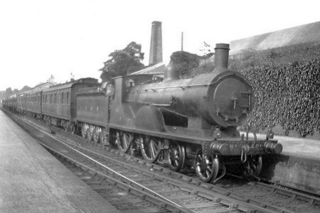
The Southern Railway (SR), sometimes shortened to 'Southern', was a British railway company established in the 1923 Grouping. It linked London with the Channel ports, South West England, South coast resorts and Kent. The railway was formed by the amalgamation of several smaller railway companies, the largest of which were the London and South Western Railway (LSWR), the London, Brighton and South Coast Railway (LB&SCR) and the South Eastern and Chatham Railway (SE&CR). The construction of what was to become the Southern Railway began in 1838 with the opening of the London and Southampton Railway, which was renamed the London & South Western Railway.

The SR Z class was an 0-8-0T 3-cylinder tank engine designed by Richard Maunsell and intended for heavy shunting on the Southern Railway, the first eight entering into service in 1929. It was a successful design and would have been built in greater numbers, but an order for a further ten was cancelled in 1930 due to the reduction in freight traffic as a result of the Great Depression.

The LSWR/SR H15 class was a class of 2-cylinder 4-6-0 steam locomotives designed by Robert Urie for mixed-traffic duties on the LSWR. Further batches were constructed by Richard Maunsell for the Southern Railway after 1923. They were given the nickname of "Junior King Arthur" due to the size of their driving wheels, the S15 and their N15 cousins had driving wheels which had a diameter of 5 foot and 7 inches and 6 foot and 7 inches respectively.
The SR N15X class or Remembrance class were a design of British 4-6-0 steam locomotives converted in 1934 by Richard Maunsell of the Southern Railway from the large LB&SCR L class 4-6-4 tank locomotives that had become redundant on the London–Brighton line following electrification. It was hoped that further service could be obtained from these locomotives on the Southern's Western Section, sharing the duties of the N15 class locomotives. The locomotives were named after famous Victorian engineers except for Remembrance, which was the LBSCR's memorial locomotive for staff members who died in the First World War.

The LSWR N15 class was a British 2–cylinder 4-6-0 express passenger steam locomotive designed by Robert Urie. The class has a complex build history spanning three sub-classes and ten years of construction from 1918 to 1927. The first batch of the class was constructed for the London and South Western Railway (LSWR), where they hauled heavy express passenger trains to the south coast ports and further west to Exeter. After the Lord Nelsons, they were the second biggest 4-6-0 passenger locomotives on the Southern Railway. They could reach speeds of up to 90 mph (145 km/h).

The SR Q1 class is a type of austerity steam locomotive constructed during the Second World War. The class was designed by Oliver Bulleid for use on the intensive freight turns experienced during wartime on the Southern Railway network. A total of 40 locomotives were built. Bulleid incorporated many innovations and weight-saving concepts to produce a highly functional design. The class lasted in service until July 1966, and the first member of the class, number C1, has been preserved by the National Railway Museum.

The SR West Country and Battle of Britain classes, collectively known as Light Pacifics or informally as Spam Cans, or "flat tops", are air-smoothed 4-6-2 Pacific steam locomotives designed for the Southern Railway by its Chief Mechanical Engineer Oliver Bulleid. Incorporating a number of new developments in British steam locomotive technology, they were amongst the first British designs to use welding in the construction process, and to use steel fireboxes, which meant that components could be more easily constructed under wartime austerity and post-war economy.

The SR class LN or Lord Nelson class is a type of 4-cylinder 4-6-0 steam locomotive designed for the Southern Railway by Richard Maunsell in 1926. They were intended for Continental boat trains between London (Victoria) and Dover harbour, but were also later used for express passenger work to the South-West of England. Sixteen of them were constructed, representing the most powerful Southern 4-6-0 design. They were all named after famous admirals.

The SR U class are 2-6-0 steam locomotives designed by Richard Maunsell for passenger duties on the Southern Railway (SR). The class represented the penultimate stage in the development of the Southern Railway's 2-6-0 "family", which improved upon the basic principles established by GWR Chief Mechanical Engineer (CME) George Jackson Churchward for Great Western Railway (GWR) locomotives. The U class design drew from experience with the GWR 4300s and N classes, improved by applying Midland Railway ideas to the design, enabling the SECR to influence development of the 2-6-0 in Britain.

The LSWR M7 class is a class of 0-4-4T passenger tank locomotive built between 1897 and 1911. The class was designed by Dugald Drummond for use on the intensive London network of the London and South Western Railway (LSWR), and performed well in such tasks. Because of their utility, 105 were built and the class went through several modifications over five production batches. For this reason there were detail variations such as frame length. Many of the class were fitted with push-pull operation gear that enabled efficient use on branch line duties without the need to change to the other end of its train at the end of a journey.

The LSWR S15 class is a British 2-cylinder 4-6-0 freight steam locomotive designed by Robert W. Urie, based on his H15 class and N15 class locomotives. The class had a complex build history, spanning several years of construction from 1920 to 1936. The first examples were constructed for the London and South Western Railway (LSWR), where they hauled freight trains to the south coast ports and further west to Exeter, as well as occasional passenger work in conjunction with their larger-wheeled N15 class counterparts.

The Q Class is a type of 0-6-0 steam locomotive designed by Richard Maunsell of the Southern Railway and constructed immediately prior to the Second World War for use on medium-distance freight trains throughout the network. Twenty locomotives were built by Maunsell's successor, Oliver Bulleid, in 1938. The design was relatively old-fashioned and the class was soon afterwards eclipsed by Bulleid's own more powerful Q1 class. Nevertheless the locomotives performed adequately and reliably on the tasks for which they had been designed, until their withdrawal in 1965. Only one has survived, and is preserved on the Bluebell Railway.

The SR U1 class were three-cylinder 2-6-0 ('mogul') steam locomotives designed by Richard Maunsell for passenger duties on the Southern Railway. The fifth member of the Maunsell "family" of standardised moguls and 2-6-4 locomotives, the U1 was the final development of the Maunsell mogul, and marked a continuation of the basic principles established by CME George Jackson Churchward for the GWR. Developed from Maunsell's previous SR U class design, the U1 class shared characteristics with Churchward's GWR 4300 Class.

The SECR N class was a type of 2-6-0 ("mogul") steam locomotive designed in 1914 by Richard Maunsell for mixed-traffic duties on the South Eastern and Chatham Railway (SECR). Built between 1917 and 1934, it was the first non-Great Western Railway (GWR) type to use and improve upon the basic design principles established by GWR Chief Mechanical Engineer (CME) George Jackson Churchward. The N class was based on the GWR 4300 Class design, improved with Midland Railway concepts.

The London and South Western Railway T9 class is a class of 66 4-4-0 steam locomotive designed for express passenger work by Dugald Drummond and introduced to services on the LSWR in 1899. One example has been preserved after British Railways ownership. They were given the nickname of "Greyhounds" due to their speed, up to 85 miles per hour (137 km/h), and reliability.

The SECR N1 class was a type of 3-cylinder 2-6-0 ('mogul') steam locomotive designed by Richard Maunsell for mixed traffic duties, initially on the South Eastern and Chatham Railway (SECR), and later operated for the Southern Railway (SR). The N1 was a development of the basic principles established by the Great Western Railway's (GWR) Chief Mechanical Engineer (CME) George Jackson Churchward and by Maunsell's previous N class design.

The LSWR Class S11 was a class of 10 4-4-0 steam locomotives designed for express passenger work by Dugald Drummond. They were introduced to services on the London and South Western Railway in 1903. None of the class survived into preservation after their brief career in British Railways ownership.

The LSWR Class T14 was a class of ten 4-6-0 locomotives designed by Dugald Drummond for express passenger use on the London and South Western Railway and constructed at Eastleigh in 1911–12.

The LSWR D15 class 4-4-0 was the last steam locomotive design by Dugald Drummond for the London and South Western Railway in 1912. By 1912, Dugald Drummond had built several classes of unsuccessful 4-6-0 express passenger locomotives. The result of these failures was that when he designed what was to be his last class in 1911, a new 4-4-0 design emerged from Eastleigh Works in February 1912, with what was to be the first of his D15 class.

The SR Merchant Navy class is a class of air-smoothed 4-6-2 (Pacific) steam locomotives designed for the Southern Railway by Oliver Bulleid. The Pacific design was chosen in preference to several others proposed by Bulleid. The first members of the class were constructed during the Second World War, and the last of the 30 locomotives in 1949.
























